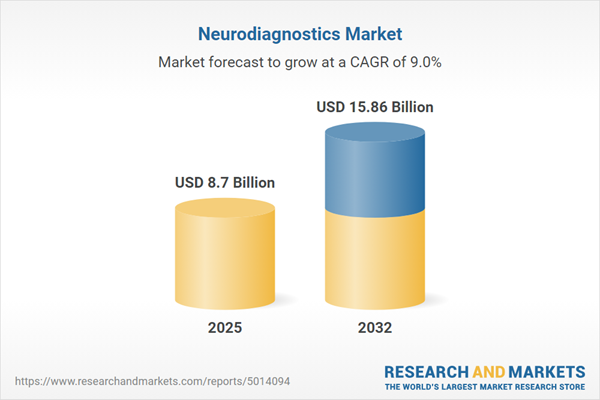Speak directly to the analyst to clarify any post sales queries you may have.
The neurodiagnostics market is rapidly evolving as the demand for early and accurate identification of neurological disorders grows across healthcare systems. Senior leaders face new opportunities and challenges while cutting-edge tools reshape diagnostics, workflows, and care delivery standards.
Market Snapshot: Neurodiagnostics Market Size and Growth
The neurodiagnostics market grew from USD 7.97 billion in 2024 to USD 8.70 billion in 2025. It is expected to continue growing at a CAGR of 8.97%, reaching USD 15.86 billion by 2032. This expansion reflects the increasing focus on early intervention and advanced patient management in neurological health.
Scope & Segmentation of the Neurodiagnostics Market
This comprehensive report offers detailed insight into market segments, application domains, and end-user categories shaping near-term and long-term opportunities:
- Technology
- Invasive: Depth Electrode Monitoring, Electrocorticography
- Noninvasive: Electrophysiology, Imaging Modalities
- Application
- Alzheimer's Disease, Lewy Body Dementia, Vascular Dementia
- Brain Tumor
- Epilepsy, Focal Epilepsy, Generalized Epilepsy
- Multiple Sclerosis
- Stroke, Hemorrhagic Stroke, Ischemic Stroke
- Trauma
- End User
- Ambulatory Clinics: Neurology Clinics, Outpatient Rehabilitation Centers
- Diagnostic Centers: Hospital Owned, Independent
- Home Care
- Hospitals: General Hospitals, Specialty Clinics
- Research Institutes
- Regions
- Americas: United States, Canada, Mexico, Brazil, Argentina, Chile, Colombia, Peru
- Europe, Middle East & Africa: United Kingdom, Germany, France, Russia, Italy, Spain, Netherlands, Sweden, Poland, Switzerland, United Arab Emirates, Saudi Arabia, Qatar, Turkey, Israel, South Africa, Nigeria, Egypt, Kenya
- Asia-Pacific: China, India, Japan, Australia, South Korea, Indonesia, Thailand, Malaysia, Singapore, Taiwan
- Key Companies Analyzed
- Siemens Healthineers AG, GE Healthcare Inc., Koninklijke Philips N.V., Canon Medical Systems Corporation, Fujifilm Holdings Corporation, Hitachi, Ltd., Natus Medical Incorporated, Nihon Kohden Corporation, Cadwell Laboratories, Inc., NeuroLogica Corporation
Key Takeaways for Decision-Makers
- Pervasive adoption of advanced digital health and wearable neurodiagnostic devices is streamlining remote and longitudinal monitoring, especially valuable for chronic condition management outside traditional clinical environments.
- Artificial intelligence and machine learning integration are enabling earlier detection of subclinical neurological events, driving faster diagnostics and optimized patient outcomes.
- Shift toward modular hardware and software platforms allows adaptable, incremental upgrades, supporting budget-conscious procurement and flexible clinical deployment strategies.
- The competitive environment is marked by strategic partnerships, research-driven innovations, and ongoing M&A activity, expanding solution portfolios and global reach.
- Decentralized monitoring and telehealth are increasingly prioritized in care pathways, aligning with the broader goal of proactive, patient-focused neurology services.
Impact of Escalated US Tariffs on Neurodiagnostic Equipment
Recent US tariffs on medical device components, effective from 2025, have increased material costs and introduced new supply chain challenges for neurodiagnostic equipment manufacturers. This has prompted companies to revisit procurement models, emphasize alternative sourcing, and invest in local manufacturing. Healthcare providers and diagnostic centers are adapting through extended evaluation cycles and choosing systems that allow for phased upgrades, ensuring operational continuity amidst shifting trade dynamics. The broader sector is responding by accelerating innovations in sensor technology and digital processing that minimize reliance on imported high-precision parts.
Methodology & Data Sources
This report employs a robust research methodology, combining secondary research from published journals, regulatory filings, and proprietary databases with primary interviews from over 40 industry experts. Data triangulation and expert validation underpin the delivery of reliable, actionable insights spanning qualitative and quantitative analyses.
Why This Report Matters
- Enables executive teams to benchmark emerging neurodiagnostics trends and consolidate early-mover advantage in key segments.
- Equips procurement leaders and strategists with detailed segmentation and region-specific intelligence to inform tactical investments.
- Facilitates understanding of tariff effects and technology readiness, supporting risk mitigation and sustainable planning.
Conclusion
The neurodiagnostics market is entering a period of transformation, bringing new tools, data integration, and patient engagement models to the forefront. Stakeholders are positioned to benefit by leveraging evolving technologies, modular approaches, and targeted regional strategies to advance neurological care standards.
Additional Product Information:
- Purchase of this report includes 1 year online access with quarterly updates.
- This report can be updated on request. Please contact our Customer Experience team using the Ask a Question widget on our website.
Table of Contents
3. Executive Summary
4. Market Overview
7. Cumulative Impact of Artificial Intelligence 2025
Companies Mentioned
The companies profiled in this Neurodiagnostics market report include:- Siemens Healthineers AG
- GE Healthcare Inc.
- Koninklijke Philips N.V.
- Canon Medical Systems Corporation
- Fujifilm Holdings Corporation
- Hitachi, Ltd.
- Natus Medical Incorporated
- Nihon Kohden Corporation
- Cadwell Laboratories, Inc.
- NeuroLogica Corporation
Table Information
| Report Attribute | Details |
|---|---|
| No. of Pages | 181 |
| Published | October 2025 |
| Forecast Period | 2025 - 2032 |
| Estimated Market Value ( USD | $ 8.7 Billion |
| Forecasted Market Value ( USD | $ 15.86 Billion |
| Compound Annual Growth Rate | 8.9% |
| Regions Covered | Global |
| No. of Companies Mentioned | 11 |









